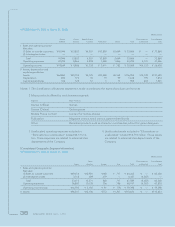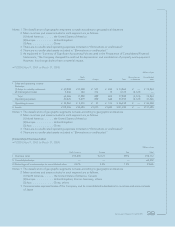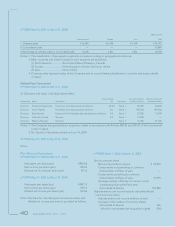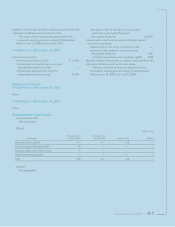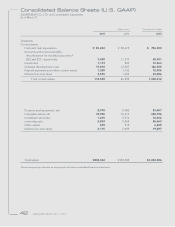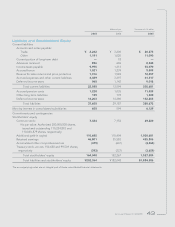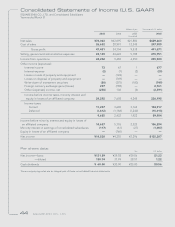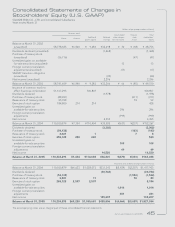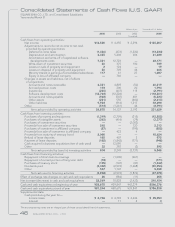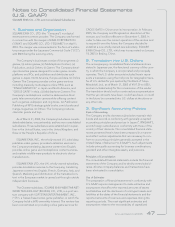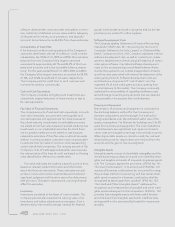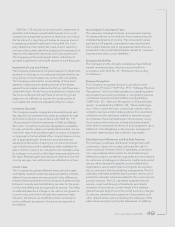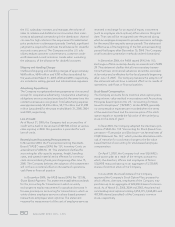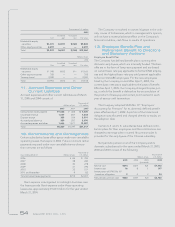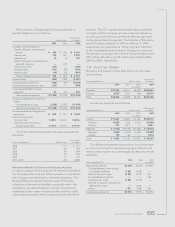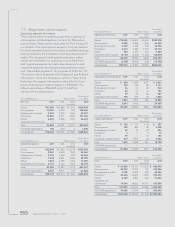Square Enix 2005 Annual Report Download - page 50
Download and view the complete annual report
Please find page 50 of the 2005 Square Enix annual report below. You can navigate through the pages in the report by either clicking on the pages listed below, or by using the keyword search tool below to find specific information within the annual report.
48 SQUARE ENIX CO., LTD.
software development costs and other intangibles, invento-
ries, realization of deferred income taxes and the adequacy
of allowances for returns, price protection and doubtful
accounts. Actual amounts could differ from these estimates.
Concentration of Credit Risk
If the financial condition and operations of the Company’s
customers deteriorate, the risk of collection could increase
substantially. As of March 31, 2005 and 2004, the receivable
balances from the Company’s five largest customers
amounted to approximately 60.1% and 40.4% of the Com-
pany’s net accounts and notes receivable balance, respec-
tively. For the years ended March 31, 2005, 2004 and 2003,
the Company’s five largest customers accounted for 25.4%,
21.6%, and 30.2% (unaudited) of net sales, respectively.
The Company sets the credit limit to each customer and
monitors its solvency continuously.
Cash and Cash Equivalents
The Company considers all highly liquid investments pur-
chased with original maturities of three months or less to
be cash equivalents.
Fair Value of Financial Instruments
The carrying amounts of cash and cash equivalents, accounts
and notes receivable, accounts and notes payable and
accrued expenses and approximate fair value because of
their short maturity. Investments in marketable securities
are stated at their fair value based on quoted market prices.
Investments in non-marketable securities for which there
are no quoted market price are stated at cost because
reasonable estimates of their fair value could not be made
without incurring excessive costs and it was not practicable
to estimate their fair value of common stock representing
certain closely held companies. The carrying amount of the
Company’s lines of credit approximates fair value because
the interest rates of the lines of credit are based on floating
rates identified by reference to market rates.
Fair value estimates are made at a specific point in time,
based on relevant market information and information
about the financial instruments. These estimates are sub-
jective in nature and involve uncertainties and matters of
significant judgment and therefore cannot be determined
with precision. Changes in assumptions could significantly
affect the estimates.
Inventories
Inventories are stated at the lower of cost or market. The
Company periodically evaluates the carrying value of its
inventories and makes adjustments as necessary. Cost is
determined by the monthly average method for finished
goods, merchandise and work in progress and, by the last
purchase price method for other supplies.
Software Development Costs
The Company applies Statement of Financial Accounting
Standards (“SFAS”) No. 86, “
Accounting for the Cost of
Computer Software to be Sold, Leased, or Otherwise Mar-
keted,
” pursuant to which, the Company capitalizes internal
software development cost, as well as content cost, subse-
quent to establishment of technological feasibility of certain
video game software. Capitalized software development
costs on the accompanying consolidated balance sheets
include the payment to an outside independent contactor
as well as costs associated with internal development of the
video game products. Software development costs are
amortized as a component of “cost of sales” over the
expected life of each video game product, starting from
its initial delivery to the market. The Company continually
evaluates the recoverability of capitalized software costs
and will charge to earnings any amounts that are deemed
unrecoverable or for projects that it will abandon.
Property and Equipment
Depreciation of property and equipment is computed on
the declining-balance method for the Company and
domestic subsidiaries, and the straight-line method for
foreign subsidiaries over the estimated useful lives of the
assets, ranging from 3 to 50 years for buildings and 3 to 20
years for machinery and equipment. The cost of additions
and betterments are capitalized, and repairs and mainte-
nance costs are charged to earnings in the periods incurred.
When depreciable assets are retired or sold, the cost and
related allowances for depreciation are removed from the
accounts and the gain or loss is recognized.
Intangible Assets
Intangible assets consist of identifiable intangibles and the
remaining excess purchase price paid over identified intan-
gible and tangible net assets of acquired companies (good-
will). The Company applies the provisions of SFAS No. 141,
“
Business Combinations
” in its entirety and SFAS No. 141
requires all business combinations be accounted for using
the purchase method of accounting and that certain intan-
gible assets acquired in a business combination shall be
recognized as assets apart from goodwill. SFAS No. 142,
“
Goodwill and Other Intangible Assets
” addresses the
recognition and measurement of goodwill and other intan-
gible assets subsequent to their acquisition. SFAS No. 142
provides that intangible assets with finite useful lives be
amortized and that intangible assets with indefinite lives
and goodwill not be amortized but tested for impairment
annually.


